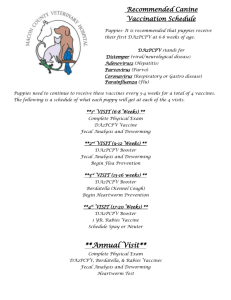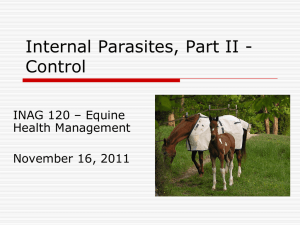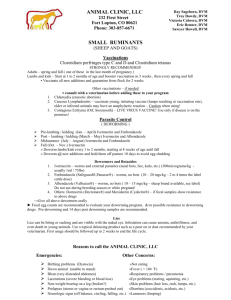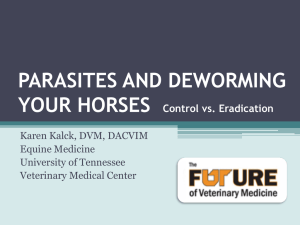Equine Health Maintenance - Greene, Lewis & Associates
advertisement
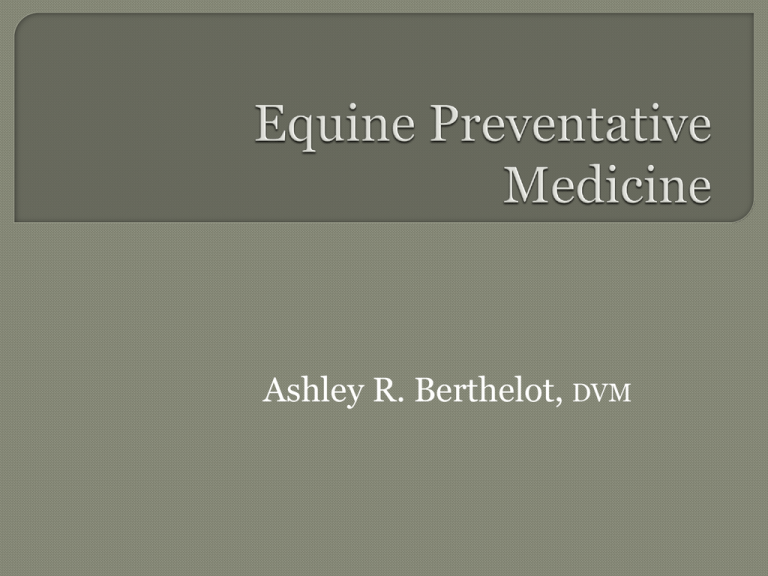
Ashley R. Berthelot, DVM Health maintenance, early detection of problems, good diagnostics, and high quality treatment translates to long-term savings for the owner. In addition, the overall well-being of the horse improves and the longevity of life and career can be increased. Establishing an effective parasite control program is probably second only to supplying the horse with clean, plentiful water and high quality feed. Internal Parasites: Silent thieves and killers Cause extensive damage Effect the horse from a dull haircoat and unthriftiness to colic and death Can decrease resistance to infection Can rob a horse of valuable nutrients Large strongyles Small strongyles Roundworms Tapeworms Lungworms Pinworms Threadworms Bots Large Strongyles: Penetrate lining of the bowel and migrate along the blood vessels that supply intestine Cause unthriftiness, weight loss, poor growth in young horses, anemia, and colic SmallStrongyles : (cyathastomes) Burrow into lining of intestine and become encysted Cause severe damage to the lining of intestine Can cause colic and diarrhea with heavy infections Weight loss, slowed growth, poor coat, and lack of energy Roundworms (Ascarids): Several inches long Most often a young horse problem In large numbers they can cause impactions Migrate through the internal organs to the lungs, coughed up, swallowed back into the digestive tract to complete lifecycle. Can cause coughing, poor body condition and growth, pot belly, rough haircoat and colic. Tapeworms: Can cause mild to severe colic Lifecycle involves a tiny mite as a host that horses ingest in the grass, grain or hay. Dull, rough haircoat Decreased energy Unthriftiness, Slow loss of condition growth in young horses Colic “Pot-bellied” Diarrhea appearance Broad spectrum Safe No dewormers are 100% effective Not necessary to kill every worm to improve health, minimize risk of disease, reduce pasture contamination, and improve feed efficiency Ivermectin (aka Eqvalan) is effective against: Large Strongyles Small Strongyles, or cyathstomes, adult only Pinworms, adult and L4 Ascarids, adult Hairworms Large-mouth Stomach Worms Bots Lungworms Intestinal Threadworms Summer Sores caused by Habonema and Draschia spp. Ivermectin is not effective against: Encysted larvae Late early third-stage cyathostome third-stage cyathostome larvae Lumenal larvae and adult cyathostomes Tapeworms Fenbendazole Safeguard) • • • • • (aka Panacur, Large strongyles Small strongyles or cyathostomes Encysted third stage cyathostome larvae Pinworms Ascarids Pyrantal Pamoate (aka Strongid) • Large strongyles • Pinworms • Large roundworms • Small strongyles 3 Basic Types of Deworming Programs: 1. Continuous 2. Interval 3. Strategic No deworming program suits all situations The ideal program depends on the type, number and ages of the horses, pasture management and location Small quantity of dewormer daily Effectively prevents new infections picked up during grazing May not resolve existing infections Does not kill bots Need bi-annual supplemental deworming Systematic, seasonal deworming program Deworm horses six times a year (every 60 days) Rotating different compounds based on seasonal parasite prevalence Rotating among the three main chemical classes of compounds available (ivermectin, fenbendazole and pyrantel pamoate) Combat the parasites that are prevalent in that season. January - Ivermectin/Praziquantel (Equimax) March - Pyrantel Pamoate (Strongid); fecal egg count preformed 10 days post deworming May - Ivermectin (Eqvalan) July - Ivermectin (Eqvalan) September - Double dose of Fenbendazole granules once a day for 5 straight days;fecal egg count preformed 10 days post deworming November - Ivermectin (Eqvalan) www.greenelewis.com Deworming based fecal egg counts Aka: Test and Treat Fecal Egg Counts Microscopic examination of fresh manure for parasite eggs Results expressed in EPG (eggs per gram) of manure Fecal egg count of less than 200 epg suggests light parasite load 500-1000 epg is moderate to heavy load Negative fecal count does not mean parasite free Certain compounds combat specific parasites more effectively than others Repeat Correct exposure can lead to resistance seasonal compound selection can decrease resistance and increase protection No great solution for preventing resistance One way to try to avoid creating resistance is to: Test and Treat Important to perform fecal egg counts every 6 – 12 months to measure the effectiveness of your program. Prevent overgrazing Reduce pasture contamination Remove manure regularly Mow/harrow pastures periodically to expose parasites to heat/sunlight Rotate pastures with other livestock Keep foals and weanlings separate from yearlings and adults Use a feeder for hay and grain rather than feeding on the ground Consult your veterinarian to set up appropriate program Perform fecal egg counts to monitor effectiveness Mankind's true moral test, its fundamental test (which lies deeply buried from view), consists of its attitude toward those who are at its mercy, animals. Milan Kundera, 1929
